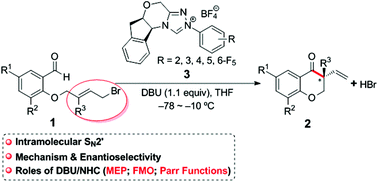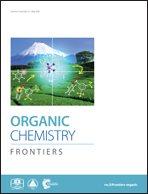Theoretical study on the mechanism and enantioselectivity of NHC-catalyzed intramolecular SN2′ nucleophilic substitution: what are the roles of NHC and DBU?†
Abstract
A possible catalytic mechanism was proposed and studied in high detail by using the density functional theory (DFT) for a recently reported enantioselective intramolecular SN2′ nucleophilic substitution of aldehydes with trisubstituted allylic bromides. The calculated results show that the catalytic cycle should occur through four stages including the nucleophilic attack of an NHC on the substrate, generation of the Breslow intermediate, SN2′ nucleophilic substitution, and finally regeneration of the NHC along with the release of the product. The possibilities that the NHC interacts with one of the olefin carbons to initiate side reactions were also calculated and carefully excluded. The SN2′ nucleophilic substitution step was demonstrated to be both the rate- and enantioselectivity-determining steps, and the energy barrier via the transition state leading to the R-configured product was lower than that leading to the S-configured one, which is in good agreement with the experimental results. The NHC was supposed to work as a catalyst to facilitate the reaction to occur, while our calculated results demonstrated that the additive base DBU should also play essential roles to enable the generation of the NHC catalyst and the most important Breslow intermediate. The electrostatic potential maps (MEPs) for some stationary points were plotted to help us analyze the roles DBU plays in the proton transfer process. The electrophilic and nucleophilic Parr functions (Pk+ and Pk−) and frontier molecular orbital (FMO) theory were applied to illustrate how NHCs could promote the reaction through the umpolung strategy. We hope this work could give deeper insight into the fundamental mechanisms of the NHC-catalyzed SN2′ substitution reactions and how DBU and NHCs cooperatively promote these sorts of reactions to occur.



 Please wait while we load your content...
Please wait while we load your content...